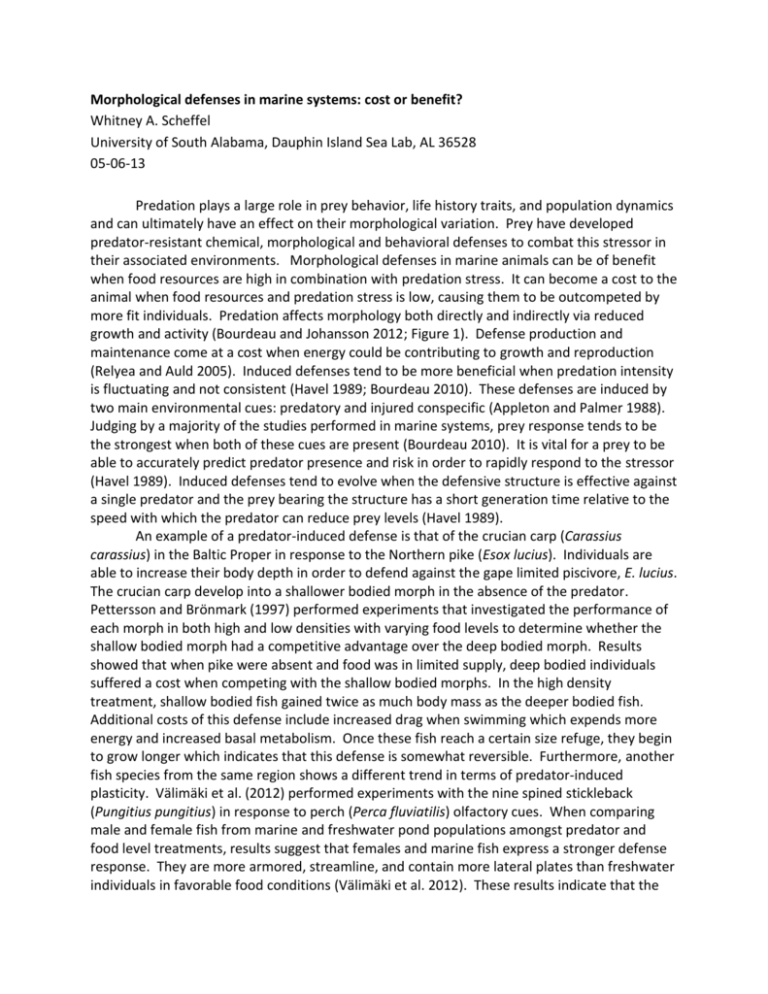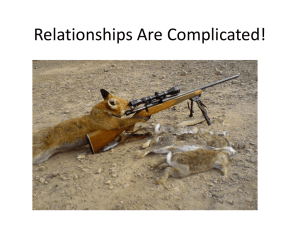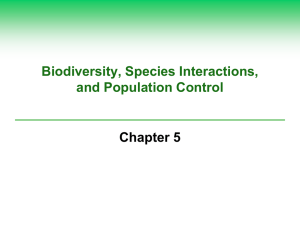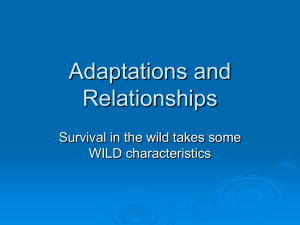whitney Scheffel Morph Defenses_Ext Abstract
advertisement

Morphological defenses in marine systems: cost or benefit? Whitney A. Scheffel University of South Alabama, Dauphin Island Sea Lab, AL 36528 05-06-13 Predation plays a large role in prey behavior, life history traits, and population dynamics and can ultimately have an effect on their morphological variation. Prey have developed predator-resistant chemical, morphological and behavioral defenses to combat this stressor in their associated environments. Morphological defenses in marine animals can be of benefit when food resources are high in combination with predation stress. It can become a cost to the animal when food resources and predation stress is low, causing them to be outcompeted by more fit individuals. Predation affects morphology both directly and indirectly via reduced growth and activity (Bourdeau and Johansson 2012; Figure 1). Defense production and maintenance come at a cost when energy could be contributing to growth and reproduction (Relyea and Auld 2005). Induced defenses tend to be more beneficial when predation intensity is fluctuating and not consistent (Havel 1989; Bourdeau 2010). These defenses are induced by two main environmental cues: predatory and injured conspecific (Appleton and Palmer 1988). Judging by a majority of the studies performed in marine systems, prey response tends to be the strongest when both of these cues are present (Bourdeau 2010). It is vital for a prey to be able to accurately predict predator presence and risk in order to rapidly respond to the stressor (Havel 1989). Induced defenses tend to evolve when the defensive structure is effective against a single predator and the prey bearing the structure has a short generation time relative to the speed with which the predator can reduce prey levels (Havel 1989). An example of a predator-induced defense is that of the crucian carp (Carassius carassius) in the Baltic Proper in response to the Northern pike (Esox lucius). Individuals are able to increase their body depth in order to defend against the gape limited piscivore, E. lucius. The crucian carp develop into a shallower bodied morph in the absence of the predator. Pettersson and Brönmark (1997) performed experiments that investigated the performance of each morph in both high and low densities with varying food levels to determine whether the shallow bodied morph had a competitive advantage over the deep bodied morph. Results showed that when pike were absent and food was in limited supply, deep bodied individuals suffered a cost when competing with the shallow bodied morphs. In the high density treatment, shallow bodied fish gained twice as much body mass as the deeper bodied fish. Additional costs of this defense include increased drag when swimming which expends more energy and increased basal metabolism. Once these fish reach a certain size refuge, they begin to grow longer which indicates that this defense is somewhat reversible. Furthermore, another fish species from the same region shows a different trend in terms of predator-induced plasticity. Välimäki et al. (2012) performed experiments with the nine spined stickleback (Pungitius pungitius) in response to perch (Perca fluviatilis) olfactory cues. When comparing male and female fish from marine and freshwater pond populations amongst predator and food level treatments, results suggest that females and marine fish express a stronger defense response. They are more armored, streamline, and contain more lateral plates than freshwater individuals in favorable food conditions (Välimäki et al. 2012). These results indicate that the nine spined stickleback does not exhibit predator-induced plasticity in their body shape or armor based on unreliable olfactory cues of the predatory perch. There is evidence for this type of defense in the mimetic relationship between the tropical bridled burrfish (Chilomycterus antennatus) and the unpalatable sea hare (Aplysia dactylomelia). Heck and Weinstein (1978) observed this relationship in Panama where they collected post-larval burrfish that resembled the more unpalatable sea hare. The burrfish is highly susceptible to predation throughout its early life stages whereas the chemically defended sea hare has very few native predators. This mimic allows them to quickly reach their adult stage where acquire protective spines and the ability to inflate their bodies (Heck and Weinstein 1978). Various marine invertebrates also express morphological defense mechanisms in response to chemical cues of their associated predator and have been the focus of many experimental studies (Lively 1986; Appleton and Palmer 1988; Bourdeau 2010; Moody and Aronson 2012). The predatory snail (Acanthina angelica) induced a shell dimorphism response by the intertidal acorn barnacle (Chthalamus anisopoma) with the two phenotypes being a volcano shaped and a bent form (Lively 1986; Lively et al. 2000). This defense mechanism became apparent after multiple settlement plate and dose-response experiments were conducted. They wanted to test two central hypotheses: (1) A. angelica either induces the bent morphology or attracts genetically determined larvae of the bent form; (2) exposing juvenile barnacles to A. angelica would cause them to mature faster. Results indicated that there was a mixture of inducible and non-inducible individuals within the same population. Non-inducible individuals had lower predation risk and greater reproductive output when surrounded by the inducible morph (Lively et al. 2000). The bent morph was induced by the predatory snail, but showed no indication of early maturity, only faster growth. Furthermore, examples of similar inducible plastic traits exist in three marine gastropods, the marsh periwinkle (Littoraria irrorata), the frilled dogwinkle (Nucella lamellosa), and the flat periwinkle (Littorina obtusata). Experimental tests were conducted to test if there were changes in the shell morphology after being exposed to predatory cues and crushed conspecifics. In the marsh periwinkle, there were novel findings of a significant increase in the rate and production of labial ridge calcification when exposed to both conspecific cues and cues from the predatory blue crab (Callinectes sapidus) (Moody and Aronson 2012). Trussell et al. (1996; 2002) saw similar results in the response of the intertidal snail L. obtusata in the presence of a common shore crab (Carcinus maenas). Snails produced thicker shells in both wave exposed and protected shorelines when exposed to crabs. When similar experiments were conducted with N. lamellosa, they developed larger apertural teeth when held in the presence of the red rock crab (Cancer productus) (Appleton and Palmer 1988). The responses were different for those exposed to crab effluent fed frozen fish and those that were fed thin shelled snails. Those snails that developed the larger teeth fed less and also grew at a slower rate (Appleton and Palmer 1988). This trait seems to be inducible with a genetic basis and does not occur as often when predation risk is low due to its energetic cost. The final example of a known inducible defense is that of the spine producing bryozoan (Membranipora membranacea), a colonial organism found encrusted upon kelp blades fed upon by the cryptic nudiranch (Doridella steinbergae) in the Pacific Northwest. Following a series of cue and predation experiments, the production of spines by the attacked colony and the adjacent target colony were greater at high nudibranch densities than those located some distance away. The amount of zooids consumed per day was significantly less for spined individuals versus unspined indicating the defense accurately deterred predation (Harvell 1986). In conclusion, the results of these studies regarding both solitary and clonal organisms’ morphologies suggest that inducible defenses are preferred when predatory cues are reliable and intermittent. These defenses may have energetic costs associated with them, but most prove to be successful at deterring predation. More experimental evidence is needed to document the relationship between prey activity, growth and defense production so we can better understand the costs and benefits of these morphological changes in various marine ecosystems. References Appleton, R. D., & A. R Palmer. 1988. Water-borne stimuli released by predatory crabs and damaged prey induce more predator-resistant shells in a marine gastropod. Proceedings of the National Academy of Sciences, 85(12), 4387-4391. Bourdeau, P. E. 2010. Cue reliability, risk sensitivity and inducible morphological defense in a marine snail. Oecologia, 162(4), 987-994. Bourdeau, P. E., & F. Johansson. 2012. Predator‐induced morphological defenses as by‐products of prey behaviour: a review and prospectus. Oikos, 121(8), 1175-1190. Havel, J.E. 1989. Predator-induced defenses: A review. Pages 263-278 in W.C. Kerfoot and A. Sih, editors. Predation: Direct and indirect impacts on aquatic communities. University Press of New England, Hanover, New Hampshire, USA. Harvell, C. D. 1986. The ecology and evolution of inducible defenses in a marine bryozoan: cues, costs, and consequences. American Naturalist, 810-823. Lively, C. M. 1986. Predator-induced shell dimorphism in the acorn barnacle Chthamalus anisopoma. Evolution, 232-242. Lively, C. M., W. N. Hazel, M.J. Schellenberge, & K.S Michelson. 2000. Predator-induced defense: variation for inducibility in an intertidal barnacle. Ecology, 81(5), 1240-1247. Moody, R. M., & R. B. Aronson. 2012. Predator-induced defenses in a salt-marsh gastropod. Journal of Experimental Marine Biology and Ecology, 413, 78-86. Pettersson, L. B., & C. Brönmark. 1997. Density-dependent costs of an inducible morphological defense in crucian carp. Ecology, 78(6), 1805-1815. Relyea, R. A., & J. R. Auld. 2005. Predator-and competitor-induced plasticity: how changes in foraging morphology affect phenotypic trade-offs. Ecology,86(7), 1723-1729. Trussell, G. C. 1996. Phenotypic plasticity in an intertidal snail: the role of a common crab predator. Evolution, 50(1), 448-454. Trussell, G. C., & M. O Nicklin. 2002. Cue sensitivity, inducible defense, and trade-offs in a marine snail. Ecology, 83(6), 1635-1647. Välimäki, K., G. Herczeg, & J. Merilä. 2012. Morphological anti‐predator defences in the nine‐ spined stickleback: constitutive, induced or both? Biological Journal of the Linnean Society, 107(4), 854-866. Figure 1: Flow chart of energy and direct and indirect (hatched arrows) effects of predation risk on prey morphology. Predation can affect morphology indirectly through changes in prey activity, growth, and stress response. Tradeoffs can occur with more allocation to growth and development. (Bourdeau and Johansson 2012)









